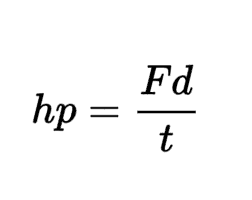
Horsepower Formula: Horsepower is a fundamental metric for assessing the performance of engines and machinery
What is Horsepower?
Horsepower is a unit of power that measures the rate at which work is done. It is commonly used in the context of engines and machinery to quantify the amount of power they can produce or consume. The term "horsepower" was originally coined by James Watt, a Scottish engineer, in the 18th century to compare the output of steam engines to the power of horses, which were widely used for various forms of work at the time.
In modern terms, one horsepower is defined as the power required to lift 550 pounds (250 kilograms) by one foot (0.3048 meters) in one second. This definition provides a standardized way to measure and compare the power output of engines and machines. It's important to note that while the concept of horsepower originated in the context of steam engines and horses, it is now applied universally to various types of engines, including internal combustion engines in vehicles, electric motors, and more.
Horsepower is a fundamental metric for assessing the performance of engines and machinery, and it plays a crucial role in the automotive and industrial sectors, allowing engineers and consumers to understand and compare the power capabilities of different devices.
The Formula for Horsepower Calculation
The formula for calculating horsepower is as follows:

|
|
= | horsepower |
|
|
= | force in pounds |
|
|
= | distance in feet |
|
|
= | time in minutes |
Alternatively
Horsepower (hp) = (Torque (lb-ft) × RPM) / 5252
In this formula:
"Horsepower (hp)" represents the power output measured in horsepower.
"Torque (lb-ft) " refers to the twisting force generated by the engine, typically measured in pound-feet (lb-ft) or newton-meters (N·m) in the metric system.
"RPM" stands for Revolutions Per Minute and indicates how fast the engine is rotating.
The formula essentially quantifies the power produced by the engine by taking into account both the engine's ability to generate torque (rotational force) and how fast it can do so (measured in revolutions per minute). The constant value "5252" is derived from the definition of one horsepower, which is the power required to lift 550 pounds by one foot in one second, and it is used to convert the units of torque and RPM into horsepower.
Also Read – Ray Optics Formula
Solved Examples on Horsepower Formula
Example 1: Calculating Horsepower from Torque and RPM
Suppose you have an engine that produces 300 pound-feet (lb-ft) of torque and operates at 3500 revolutions per minute (RPM). Calculate its horsepower.
Horsepower (hp) = (Torque (lb-ft) × RPM) / 5252
Horsepower (hp) = (300 lb-ft × 3500 RPM) / 5252
Horsepower (hp) = (1,050,000 lb-ft-RPM) / 5252
Horsepower (hp) ≈ 200 hp
So, the engine in this example produces approximately 200 horsepower.
Also Read – Semiconductors Devices Formula
Example 2: Determining Torque from Given Horsepower and RPM
Imagine a car engine that generates 250 horsepower and operates at 6000 RPM. Calculate its torque.
To find torque, we can rearrange the formula:
Torque (lb-ft) = (Horsepower (hp) × 5252) / RPM
Torque (lb-ft) = (250 hp × 5252) / 6000 RPM
Torque (lb-ft) ≈ 219 lb-ft
In this case, the engine produces approximately 219 pound-feet of torque.
These examples illustrate how you can use the horsepower formula to calculate either horsepower when torque and RPM are known or torque when horsepower and RPM are known. It's a valuable tool for evaluating the power output of engines and machinery in various applications.
Also Read – Current Electricity Formula
Applications of Horse Power Formula
- Automotive Industry: Horsepower is prominently used in the automotive industry to quantify the power output of engines. It directly affects a vehicle's performance, determining aspects like acceleration, top speed, and towing capacity.
- Agriculture: In agriculture, tractors and other machinery use horsepower to measure their capacity to perform tasks like plowing fields, harvesting crops, and running irrigation systems.
- Construction and Heavy Machinery: Heavy equipment such as bulldozers, excavators, and cranes rely on horsepower to assess their ability to move heavy loads and perform construction tasks efficiently.
- Aviation: Aircraft engines are rated in terms of horsepower. This metric is crucial for calculating the thrust needed for takeoff and maintaining flight.
- Marine Industry: Boat engines, especially in larger vessels, are rated in horsepower. It dictates the speed and carrying capacity of boats and ships.
- Manufacturing: Industrial machinery often employs powerful motors rated in horsepower for manufacturing processes, such as stamping, molding, and cutting.
- Mining: In mining operations, heavy machinery like drilling rigs and haul trucks rely on high horsepower to extract and transport minerals efficiently.
- Energy Generation: Power plants, whether fossil fuel-based or renewable, use large generators rated in horsepower to produce electricity.
- Sports and Racing: In motorsports like Formula 1 and NASCAR, horsepower plays a critical role in determining a vehicle's competitive edge, as more horsepower often translates to higher speeds.
- Rail Transportation: Locomotives use horsepower ratings to gauge their pulling capacity and efficiency in moving freight and passengers.
- Engineering and Design: Engineers and designers use horsepower calculations to select suitable motors and engines for various applications, ensuring they have adequate power.
- Science and Research: In scientific experiments and research projects, instruments and equipment often use motors or engines rated in horsepower to perform tasks and measurements.
These applications showcase the versatility of horsepower as a metric for assessing power output and performance across multiple industries. Writing an article on this topic, including explanations and examples, can provide valuable insights into the importance of horsepower in various fields.
Horsepower Formula FAQs
What is Horsepower and how is it defined?
How is Horsepower calculated in engines?
Why is Horsepower important in the automotive industry?
What's the difference between Brake Horsepower (BHP) and Wheel Horsepower (WHP)?
Can you convert Horsepower to other units of power?










